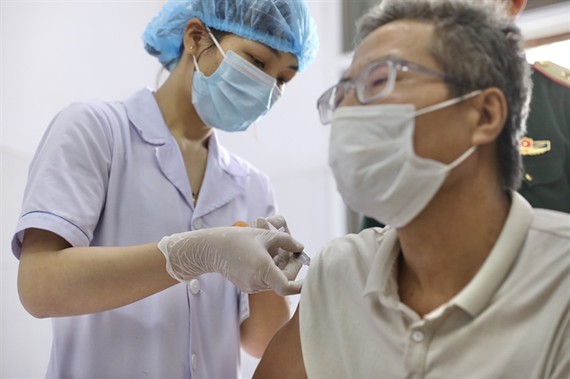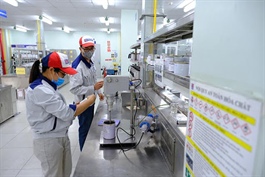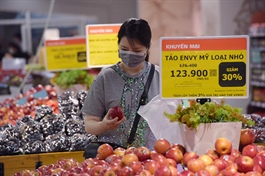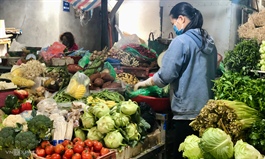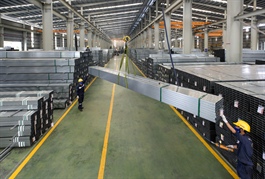Pandemic spreads, but Việt Nam now more sophisticated
Pandemic spreads, but Việt Nam now more sophisticated
With three more provinces recording community COVID-19 infections last week, the pandemic continued to spread, but Việt Nam has also become more sophisticated in the way it is fighting the virus.
A volunteer gets a Nano Covax vaccine jab in the third trial in Hưng Yên Province on Friday. The vaccine is developed by Vietnamese Nanogen Pharmaceutical Biotechnology JSC, VNA/VNS Photo
|
Bình Phước, Bình Định, and Bà Rịa-Vũng Tàu all found new infections, meaning a total of 51 provinces and cities have been hit amid the ongoing fourth wave of infections. The total number of cases in Việt Nam has now exceeded 18,000.
HCM City has reported more than 4,500 cases since the beginning of the fourth wave, and the number is predicted to rise as people who later tested positive for the virus had visited 55 out of the 130 hospitals in the city.
The situation in Bình Dương Province is also tense with the number of cases on the rise and local leaders asking for help from the Ministry of Health. The province on Thursday asked the ministry and the Pasteur Institute in HCM City to send health experts and medical workers soon to speed up the epidemiological investigation, contact tracing and testing.
It also asked the ministry to dispatch doctors and nurses to treat COVID-19 patients.
Production maintained
Bắc Giang and Bắc Ninh, two of the worst-hit COVID-19 localities in the country in the past two months, have resumed most manufacturing activities.
According to Lê Ánh Dương, chairman of Bắc Giang Province People's Committee, 222 companies with 55,400 employees had resumed operations after two months of disruption. More than 5,700 local cases have been reported in the province in the latest COVID-19 wave since April.
In July, industrial areas in the province will resume full operation.
The province, home to the lychee fruit, has also sold 200,000 tonnes of lychee, with pandemic prevention measures in place for truck drivers and traders.
In neighbouring Bắc Ninh, 997 companies with 255,000 employees have resumed operations.
The province has recorded more than 1,300 cases in the fourth wave.
Nguyễn Hương Giang, chairwoman of the province’s People’s Committee, said if the province suspended the operations of local industrial zones, 450,000 workers would be laid off.
“In that case, the economic consequences would be serious, affecting the supply chain on a large scale,” she said.
The move to maintain production was made with anti-pandemic measures strictly imposed. Companies provided three meals a day within their factories to prevent contagion and arranged accommodation for employees on site. Some 40 working groups to support companies were set up by local authorities.
All schools are ordered to be prepared in case enterprises need spaces for workers to stay.
“Thanks to this, the production chain was maintained,” Giang said.
More than 220,000 people have been vaccinated in Bắc Ninh Province, including more than 138,000 workers.
In July, Bắc Ninh will start construction of the VSIP2 Industrial Zone and present a certificate of an investment of more than US$300 million. The groundbreaking ceremony for another industrial zone, Thuận Thành 1, will also take place.
Many areas of Bắc Ninh have reported no new cases in the past 21 days.
Digital transformation and technology
Last Saturday, Minister of Information and Telecommunications Nguyễn Mạnh Hùng said the pandemic could be a blessing in disguise for the country’s digital transformation cause.
For instance, he said, if localities could connect vaccination information with electronic health records, all Vietnamese citizens would have electronic health records this year. In fact, the Ministry of Information and Telecommunications had the electronic health record system ready for localities to use when vaccinating citizens, he said.
He cited another example regarding e-government, saying the country had been working on this for 20 years. It took Việt Nam 10 years to put public services online, but 78 per cent of people still use in-person services.
“If we take advantage of the social distancing period and stop using in-person services, I think it would only take a few months for people to be used to using online services. That process would take 10 years in normal circumstances,” he said.
The same thing could be applied to education, healthcare and e-commerce, the minister said.
Technology had also helped tremendously in anti-pandemic activities, he added.
Since the beginning of the pandemic, the Government had established a national technology centre for COVID-19 prevention and control.
Nguyễn Thế Trung, Chairman DTT Technology Group, a member of the Steering Committee for COVID-19 Prevention and Control, said technology was of great help to his team in tracing cases and their contacts and other anti-pandemic activities.
The virus had changed over time, so we must also be as quick and swift to fight it, Trung said.
“We don’t try to use technology here just because it’s something trendy, but because we think we can raise the pandemic prevention and control capacity; our goal is to be quicker in everything compared to yesterday.”
Since the first wave of COVID-19 occurred in Việt Nam in 2020, the team's ability to trace and zone off virus contacts had improved remarkably.
Previously, it took the team a week to trace and zone passengers from a flight, now it only takes a few minutes with the health declaration system and computer programmes that can automatically contact people at risk of infection, he said.
In 2020, authorities required two weeks of social distancing in Hà Nội to curb the virus, but this year the time for Hà Tĩnh Province was only three days.
“We worked day and night to analyse data and track cases’ contacts. It’s very normal for me to receive a phone call or text message at three or four in the morning. And in a few minutes or an hour, we have to deal with the problems that arise,” Trung said.
“It’s also normal for government officials who are in charge to attend COVID meetings at day and stay up to work at night with us,” he said.
Vaccine on the way
The Government has announced it would provide VNĐ7.6 trillion (US$332 million) to buy 61 million doses of AstraZeneca and Pfizer COVID-19 vaccines.
The money will come from the State budget and the COVID-19 vaccine fund.
The Ministry of Health will use the money to buy, through the Vietnam Vaccine Joint Stock Company (VNVC), 30 million doses made by British-Swedish pharmaceutical company AstraZeneca and 31 million doses produced by American drugmaker Pfizer.
To date, the country has received more than 4 million doses of AstraZeneca's vaccine, including 2.5 million doses from the COVAX Facility, more than 400,000 doses via VNVC and more than 1 million doses donated by the Japanese Government.
The Government aims to secure 150 million doses this year to inoculate 70 per cent of the population.
About 350 volunteers in Hưng Yên Province on Friday received the first shot of the homegrown Nano Covax vaccine in the third and final stage of human trials. The phase 3 injections will be implemented in six districts of Hưng Yên Province with 4,000 people.
About 3.8 million people have been immunised so far, including more than 2.57 million doses in June alone. As many as 204,000 people were given both shots.


